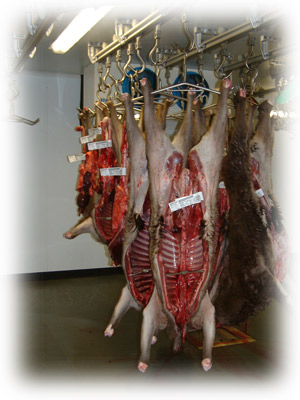Aim

Situations may arise which require exceptional numbers of deer to be culled, for example in the need to protect the environment/crops or public safety. This may result in a volume of carcasses which exceeds the quantity normally handled. Handling exceptional numbers of carcasses may therefore require amendment to normal procedures and additional resources. The aim of this guide is to outline some of the key factors to consider when planning and undertaking the handling of large numbers of carcasses.
Planning & procedures
It is probable that different teams will be responsible for different stages. Extra planning and good communications will be required to carry out the operation efficiently.
Health & Safety
Culling, extraction and lardering of exceptional numbers of carcasses is time consuming, labour intensive and can be physically demanding.
- Ensure that an appropriate risk assessment has been carried out and recorded where appropriate*.
- Follow Health and Safety Executive (HSE) guidance and ensure that activities adhere to the relevant Health & Safety Legislation (e.g. Working Time Regulations) 1 **.
- Estimate the number of carcasses expected and consider whether this number can be extracted, processed and stored with existing manpower, equipment and facilities.
Communication
- Extracting and processing large number of carcasses has the potential to generate adverse publicity. Ensure you have a communications strategy in place.
- Ensure that there is effective communication between the cull team and those responsible for extraction and processing.
Extraction
- Every effort should be made to extract carcasses; however in certain circumstances this may not be possible.Managers must consider:
• whether it is cost-effective to extract all carcasses;
• whether Health & Safety implications dictate extraction is not possible;
• the possibility of adverse publicity of not extracting and put in place a communications strategy;
• the likelihood of carcasses causing increased scavenger activity in the area - Establish how and when extraction will take place.
- Where those culling are responsible for extraction and processing, establish at what time it will be necessary to cease culling and begin extraction, and who will take the decision.
- Ensure there is a process in place to ensure extracted carcasses are lardered to the standards required for venison to enter the food chain.
Gralloching & lardering
- Determine where carcasses will be gralloched, with the understanding that if the carcass is to be eaten then gralloching should take place within 30 minutes.
- Ensure there are procedures in place to ensure carcasses are lardered to the standards required for venison to enter the food chain. Establish working methods for those extracting and lardering.
- Establish procedures to ensure that the temperature of carcasses steadily decreases and that they will reach 7°C within a reasonable time. Ensure that those which do not can be identified.
- Ensure that there is capacity to dispose of expected quantities of waste and contaminated carcasses, and establish a contingency plan to deal with any excess.***
- Arrange for carcasses to be uplifted at the earliest opportunity.
Larder capacity
- Where existing capacity is not adequate consider the following options:
• Obtain the use of a nearby larder;
• Hire or borrow local or mobile facilities/ equipment;
• Sell unlardered carcasses direct to a Venison dealer who will take delivery of them immediately after extraction;
• Establish a drop-off point for carcasses awaiting lardering / uplift;
• Create an additional lardering area.
Carcass handling
Extraction
- Ensure that those extracting are kept informed of number and location of carcasses.
- If carcasses must be left on the hill, gralloch and inspect for signs of disease.****
- In areas where the carcass is left in situ, ensure that it is not within 20 metres of any water course.****
- Where carcass is not intended for human consumption, in areas of frequent use by the public, bury insitu or extract and dispose of either by licensed route or burial.
Larder
- Ensure that those lardering are kept informed of numbers and their approximate estimated time of arrival (e.t.a).
- Ensure a “trained” person is available to carry out an on the spot examination of deer carcasses.
- Ensure that proper records are kept to ensure traceability (ideally in a larder record). Record the following:
• Place, time and date of culling
• Name of the “trained” person who inspected the carcass
• Details of any abnormal behaviour, injury or disease observed.
A tag bearing these details and signed by the trained hunter should also be attached to the carcass. *****
Storing carcasses awaiting lardering/uplift
- Arrange carcasses so they continue to cool and do not stack carcasses.
- Utilise areas where carcasses will not become muddy or contaminated with faeces.
- An additional processing area may make use of buildings or be established in the open. An area of concrete will provide a suitable surface
- Where carcasses are lardered outwith a larder, ensure surfaces and equipment are cleaned, and waste disposed of, following
- BPG Lardering and Waste Disposal and BPG Hygiene Principles.
- Where the area is established in the open field, ensure that dogs and other animals do not have access immediately before or while lardering is carried out.
- Where flies are active:
•Minimise accessibility;
•Use fly control where possible;
•Reduce areas on the carcass attractive to flies;
• Be vigilant for and remove eggs;
•Have carcasses uplifted by venison dealer as soon as possible. - Ensure that air can flow freely around and between carcasses and ensure that there is no contact between skins and exposed meat.
